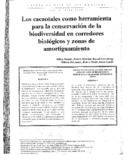Los cacaotales como herramienta para la conservación de la biodiversidad en corredores biológicos y zonas de amortiguamiento
ISSN
1022-7482Date
1999Auteur
Parrish, Jeffrey
Reitsma, Roberto
Greenberg, Reitsma
McLarney, William
Mack, Roberto
Lynch, James
Autor Corporativo
CATIE – Centro Agronómico Tropical de Investigación y Enseñanza
Type
Artículo
Metadata
Afficher la notice complèteAlternative title
Cocoa plantations as tool for the conservation of biodiversity biological corredors and buffer zones
Description
1 figura, 24 ref. Sum. (En,Es)
Résumé
Debido al avance de la deforestación, los agroecosistemas se convierten en elementos claves para la conservación de la biodiversidad. Los cacaotales, por su estructura boscosa, son una herramienta valiosa para este propósito, especialmente en zonas de amortiguamiento de áreas protegidas. El diseño y manejo de los árboles de sombra del cacao determina en gran medida el valor del cacaotal para conservar y manejar la biodiversidad. Los estudios demuestran que la diversidad de aves, mamíferos no voladores y artrópodos presentes en los cacaotales adyacentes a zonas boscosas es similar a la de los bosques naturales y mucho mayor que la de los agroecosistemas manejados intensivamente. En este artículo se hacen algunas recomendaciones para incrementar la biodiversidad en cacaotales y se proponen incentivos para el desarrollo de una producción cacaotera amigable con la biodiversidad.
As a result of deforestation, agroecosystems are becoming key elements for the conservation of biodiversity cocoa plantations, because of their forest-like structure, are a valuable tool for this purpose, especially in buffer zones around protected areas. The design and management of the cocoa shade trees determines to a large degree the value of cocoa plantation for the conservation and management of biodiversity. Studies have shown that the diversity of birds, flightless mammals and arthropods, present in cocoa plantations adjacent to forest areas, is similar to that of the natural forest and much greater than that of intensively managed agroecosystems. In this article, recommendations that can increase the biodiversity of cocoa plantations are listed and incentives are proposed for the development of “biodiversity-friendly” cocoa production. As a result of deforestation, agroecosystems are becoming key elements for the conservation of biodiversity cocoa plantations, because of their forest-like structure, are a valuable tool for this purpose, especially in buffer zones around protected areas. The design and management of the cocoa shade trees determines to a large degree the value of cocoa plantation for the conservation and management of biodiversity. Studies have shown that the diversity of birds, flightless mammals and arthropods, present in cocoa plantations adjacent to forest areas, is similar to that of the natural forest and much greater than that of intensively managed agroecosystems. In this article, recommendations that can increase the biodiversity of cocoa plantations are listed and incentives are proposed for the development of “biodiversity-friendly” cocoa production.
Keywords
Éditeur
CATIE, Turrialba (Costa Rica)


